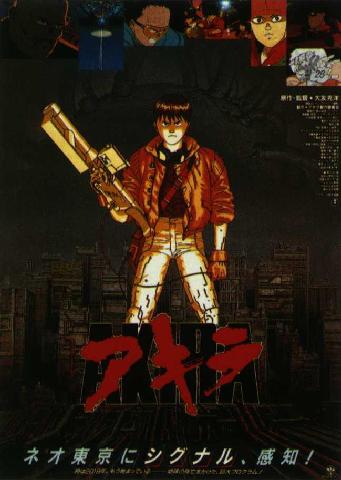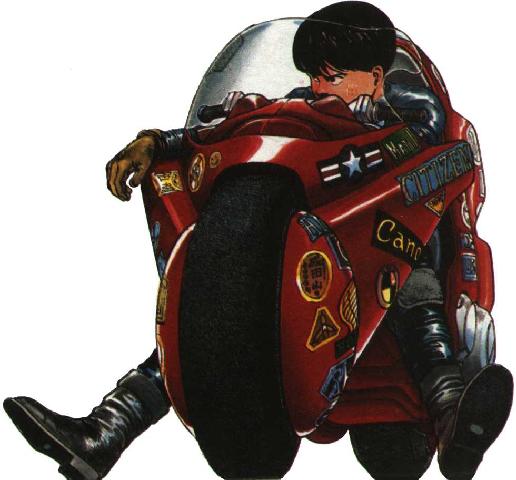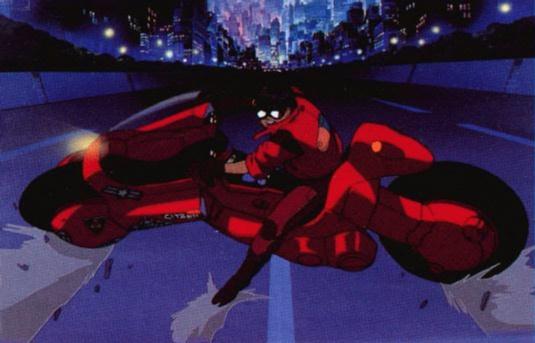


BACKGROUND:
The anime is based off the manga(or comic)Akira, which was published by Kodansha in 1983 and 1984. Before Akira's release, there wasn't much in the way of manga for high school and college students. Akira changed that, opening up a whole new market for manga.
The manga was eventually redistributed in a series of 5 giant book editions, each of which were best sellers. In 1988, the manga made it's way to America, published by Epic, a division of Marvel Comics. The english version was also colorized. It had some of the most impressive coloring in a comic book ever, at the time.
The english version finally finished publication in late 1995.
Katsuhiro Otomo was soon presented with the oppurtunity to turn Akira into an anime. He was actually involved with the creation of the film, something manga artists and writers rarely get to do. Otomo took on the project enthusiastically. He was the director, and in charge of the story, screenplay, and storyboards. Most impressive perhaps is his turning an 1800 page story into a 2 hour anime film. The transition is pulled off rather well. The films greatness is due a great part to his never compromising for second best. He loves his work, and wants it to be perfect. We wouldn't have it any other way!
ANIME ANALYSIS:
This anime was revolutionary in the industry, for it proved that animation could be for more than just for little kids. The film is one of the most complex, thought out story's ever to be presented in animation form.
There are many themes in Akira, but the theme most explored is power. This is shown on many levels; from the government trying to control the society gone wild, to the army trying to control a power beyond human comprehension. Also shown is the fact that absolute power, corrupts absolute. Tetsuo is the epitomy of what power in the wrong hands can do. The film points out what humanity is capable of.
I find it interesting that the film revolves around one boy, and the impact he has on everybody's lives. Everyone is seeking him for their own reasons. The people hold him in legend as their savior. The army has him, and they seek to understand his power for their own goals. Kaneda and his friends want to figure out just who Akira is, and Tetsuo wants to find the source of his power. Akira, in a way, becomes their holy grail. They all quest for it, yet the toll is too great to recieve.
 The film has many interesting characters, all of which are very believable, and very human. Kaneda, the rebelious gang leader, may be the star of the film; but it is Tetsuo that is the most fascinating. He is a troubled boy, with a inferiority complex and is picked on by everybody. He never had a stable mind to begin with, and the powers he recieved pushed him over the edge. He wanted to be the man everybody looks up to, and ended up the man everybody fears.
The film has many interesting characters, all of which are very believable, and very human. Kaneda, the rebelious gang leader, may be the star of the film; but it is Tetsuo that is the most fascinating. He is a troubled boy, with a inferiority complex and is picked on by everybody. He never had a stable mind to begin with, and the powers he recieved pushed him over the edge. He wanted to be the man everybody looks up to, and ended up the man everybody fears.
Actually, in a film that makes it hard to cheer for a hero, I find myself siding with Tetsuo every time I watch it. You cannot help but sympathize with him. Yes, he may be the "bad guy", but his strong, determined will always impresses me. He strives to rise above his lot in life, and does so in a way no one could have imagined! In the scene right after Tetsuo and Kaori are attacked by the clown gang, he becomes violently angry, and even snaps at his friends. He then says the most omminous words in the movie. "You think I'm a loser! It's not my fault I was smaller! Well there will come a day when I'll show all of you! Don't you forget it!" How can we ever forget, upon seeing the ending to the film?!
 But the characters are just half of what makes this film rememberable. The picture moves at breakneck speed, hardly ever letting up. Everyone in the film seems to be racing against time to keep a tragedy from happening, and the animation moves in such ways that we seem to be right along for the ride. This was the desired affect the film crew wanted, and they pulled it off nicely. There are also many symbolic images in the film, that also help to emphasize this film's themes. As the film progresses, we are shown a breakdown of society, with riots in the streets. The government is also shown to be breaking up, leading to the military coup. And as the story moves on we see Tetsuo slowly lose his sanity. All three emphasize the theme of chaos the film so strongly portrays.
But the characters are just half of what makes this film rememberable. The picture moves at breakneck speed, hardly ever letting up. Everyone in the film seems to be racing against time to keep a tragedy from happening, and the animation moves in such ways that we seem to be right along for the ride. This was the desired affect the film crew wanted, and they pulled it off nicely. There are also many symbolic images in the film, that also help to emphasize this film's themes. As the film progresses, we are shown a breakdown of society, with riots in the streets. The government is also shown to be breaking up, leading to the military coup. And as the story moves on we see Tetsuo slowly lose his sanity. All three emphasize the theme of chaos the film so strongly portrays.
On a final note, the film may be seen by some as just a message: that anarchy is coming. Yet that is not the true message. The film talks greatly of humanity's potential, for good and for evil. Even though the city is for the most part destroyed at the end, it shows Kaneda making peace with Tetsuo, and it seems that the survivors will strive to form a better place to live. Indeed, even though the tragedy unfolded, just like everyone feared it would, the final scene seems to emphasize redemption. Kaneda and Kay and Kai are staring around at the wreckage, when the sun shines through the clouds. The scene seems to say that the nightmare is over, and a new dawn is at hand. Will order come out of chaos? Like the last words of the film say, "Someday we will be. It has all ready begun..."
OTHER INFO:
LINKS:
E-mail me if you have some good links!
Back to the home page!
Back to the anime page!